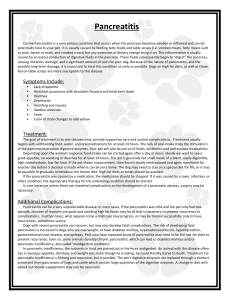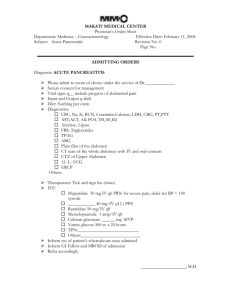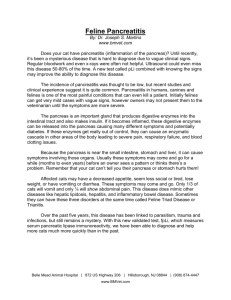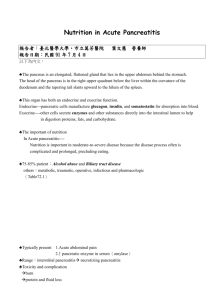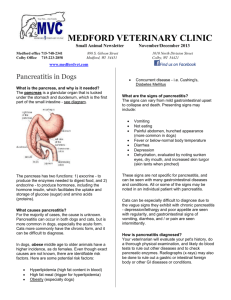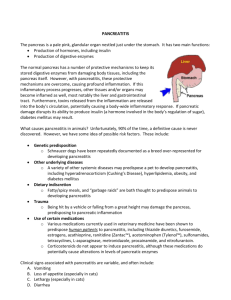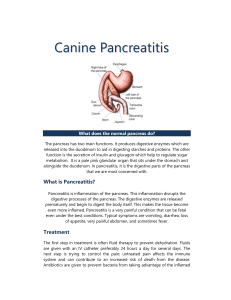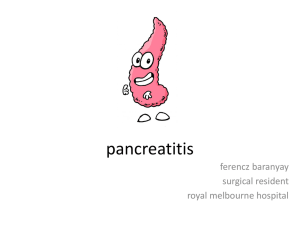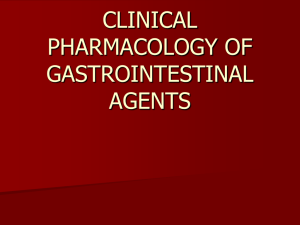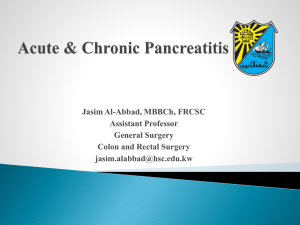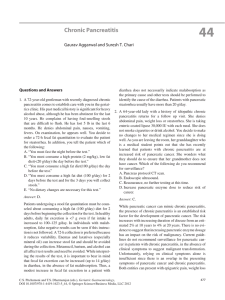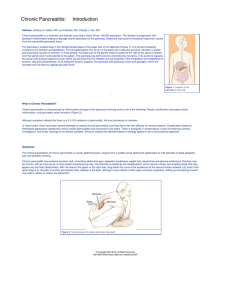What is Pancreatitis?
advertisement
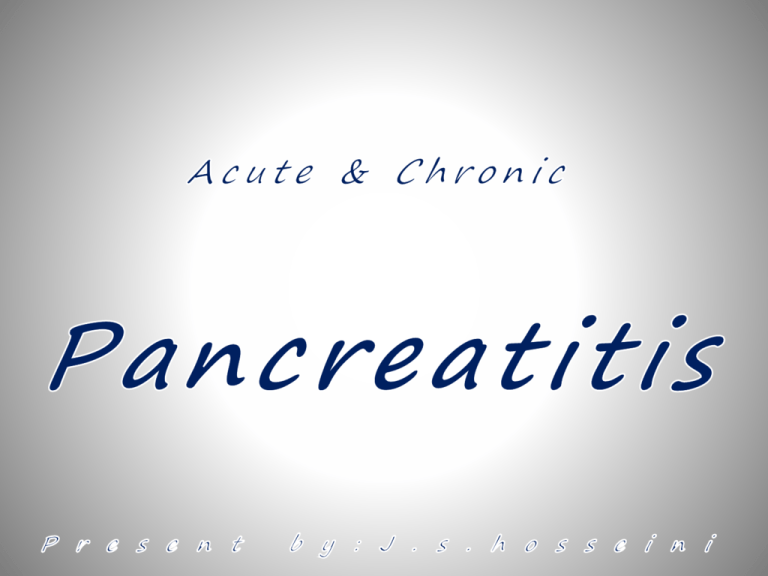
Anatomy Retroperitoneal Organ Weighs 75 To 100 G 15 To 20 Cm Long Head Neck Body Tail 2 What is Pancreatitis? Inflammation or infection of the pancreas Normally digestive enzymes secreted by the pancreas are not active until they reach the SI. When the pancreas is inflamed, the enzymes damages the tissue that produce them. attack and 2 types: 1. Acute Pancreatitis 2. Chronic Pancreatitis 3 Acute Pancreatitis 4 Definition and Incidence Inflammatory disease with little or no fibrosis. Initiated by several factors: 90% of acute pancreatitis is secondary to acute cholelithiasis or ETOH abuse Develop additional complications 300,000 cases occur in the united states each year leading to over 3000 deaths. 5 Etiology: (GET SMASHED) G: Gallstone E: Ethanol T: Trauma S: Steroid M: Mump A: Autoimmune S: Scorpion bits H: Hyperlipidemia E: ERCP D: Drugs 6 Clinical Presentation • Abdominal pain – Epigastric – Radiates to the back – Worse in supine position • • • • • • 7 Nausea and vomiting Garding Tachycardia, Tachypnea, Hypotension, Hyperthermia Elevated Hematocrit & Pre renal azotemia Cullen's sign Grey Turner's sign Grey Turner sign 8 Cullen’s sign Diagnosis: Biochemical – CBC – serum amylase • Increased Hb • Nonspecific • Thrombocytosis • Returns to normal in 3-5 • Leukocytosis days • Normal amylase does not exclude pancreatitis • Level of elevation does not – Liver Function Test • Serum Bilirubin elevated predict disease severity • Alkaline Phosphatase elevated – Urinary amylase • Aspartate Aminotransferase – P-amylase elevated – Serum Lipase 9 Assessment of Severity • Criteria • 1.ranson • 2.APACHE-2 • Biochemical Markers • Computed Tomography Scan 10 Ranson Criteria Criteria for acute gallstone pancreatitis • Admission – – – – – • During first 48 hours Age > 70 WBC > 18,000 Glucose > 220 LDH > 400 AST > 250 – Hematocrit drop > 10 points – Serum calcium < 8 – Base deficit > 5.0 – Increase in BUN > 2 – Fluid sequestration > 4L <2 pos sign: mortality rate is 0 3-5 pos sign: mortality rate is 10 to 20% >7 pos sign: mortality rate is >50% 11 CT scans of normal kidneys and pancreas Stomach Liver V A R Kidney 12 L Kidney Spleen Pancreatic Necrosis 13 Treatmaent of Mild Pancreatitis • Pancreatic rest • Supportive care – fluid resuscitation – watch BP and urine output – Pain Control – NG tubes and H2 blockers or PPIs are usually not helpful • Refeeding (usually 3 to 7 days) If: – Bowel Sounds Present – Patient Is Hungry – Nearly Pain-free (Off IV Narcotics) – Amylase & Lipase Not Very Useful 14 Treatment of Severe Pancreatitis • Pancreatic Rest & Supportive Care – – – – – Fluid Resuscitation – may require 5-10 liters/day Careful Pulmonary & Renal Monitoring – ICU Maintain Hematocrit Of 26-30% Pain Control – PCA pump Correct Electrolyte Derangements (K+, Ca++, Mg++) • Contrasted CT scan at 48-72 hours • Prophylactic antibiotics if present • Nutritional support 15 – May be NPO for weeks – TPN Complications • Local – Phlegmon, Abscess, Pseudocyst, Ascites – Involvement of adjacent organs, with hemorrhage, thrombosis, bowel infarction, obstructive jaundice, fistula formation, or mechanical obstruction • Systemic – – – – – – – – 16 A. Pulmonary: pleural effusions, atelectasis, hypoxemia, ARDS. B. Cardiovascular: myocardial depression, hemorrhage, hypovolemia. C.Metabolic:Hypocalcemia,hyperglycemia,Hyperlipidemia,coagulopathy D. GI Hemorrhage E. Renal F. Hematologic G. CNS H. Fat necrosis Management 17 Chronic Pancreatitis 18 Definition and Prevalence • Defined as chronic inflammatory condition that causes irreversible damage to pancreatic structure and function. • Incurable • 5 To 27 Persons Per 100,000 19 Etiology • Alcohol, 70% • Idiopathic (including tropical), 20% • Other, 10% – – – – – – – 20 Hereditary Hyperparathyroidism Hypertriglyceridemia Autoimmune pancreatitis Obstruction Trauma Pancreas divisum Classification: 1. calcific pancreatitis 2. obstraction pancreatitis 3. inflammatory pancreatitis 4. auto immune pancreatitis 5. asymptomic fibrosis 6. tropical pancreatitis 7. hereditary pancreatitis 8. idiopathic pancreatitis 21 Signs and Symptoms • • • • • • 22 Steady And Boring Pain Not Colicky Nausea Or Vomiting Anorexia Is The Most Common Malabsorption And Weight Loss Apancreatic Diabetes Laboratory Studies Tests for Chronic Pancreatitis I. Measurement of pancreatic products in blood A. Enzymes B. Pancreatic polypeptide II. Measurement of pancreatic exocrine secretion A. Direct measurements 1. Enzymes 2. Bicarbonate B. Indirect measurement 1. Bentiromide test 2. Schilling test 3. Fecal fat, chymotrypsin, or elastase concentration 4. [14C]-olein absorption III. Imaging techniques A. Plain film radiography of abdomen B. Ultrasonography C. Computed tomography D. Endoscopic retrograde cholangiopancreatography 23 E. Magnetic resonance cholangiopancreatography Pancreatic calcifications. CT scan showing multiple, calcified, intraductal stones in a patient with hereditary chronic pancreatitis Endoscopic retrograde cholangiopancreatography in chronic pancreatitis. The pancreatic duct and its side branches are irregularly dilated 24 features • The cardinal CT features of CP are pancreatic atrophy, calcifications, and main pancreatic duct dilation . 25 CT ERCP • ERCP is a highly sensitive radiographic test for CP. 26 MRCP • MRCP allows a noninvasive alternative to ERCP for imaging the pancreatic duct. 27 EUS EUS is a minimally invasive test that allows simultaneous assessment of ductal and parenchymal structure. 28 Treatment • • • • • • 29 Analgesia Enzyme Therapy Antisecretory Therapy Neurolytic Therapy Endoscopic Management Surgical Therapy Complications • • • • • 30 Pseudocyst Pancreatic Ascites Pancreatic-Enteric Fistula Head-of-Pancreas Mass Splenic and Portal Vein Thrombosis 31 Management 32 33
